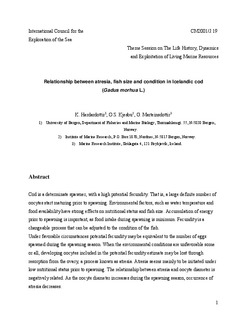| dc.contributor.author | Hardardottir, Kristin | |
| dc.contributor.author | Kjesbu, Olav Sigurd | |
| dc.contributor.author | Marteinsdottir, Gudrun | |
| dc.date.accessioned | 2007-07-16T10:01:17Z | |
| dc.date.issued | 2001 | |
| dc.identifier.uri | http://hdl.handle.net/11250/100479 | |
| dc.description.abstract | Cod is a determinate spawner, with a high potential fecundity. That is, a large definite number of
oocytes start maturing prior to spawning. Environmental factors, such as water temperature and
food availability have strong effects on nutritional status and fish size. Accumulation of energy
prior to spawning is important, as food intake during spawning is minimum. Fecundity is a
changeable process that can be adjusted to the condition of the fish.
Under favorable circumstances potential fecundity may be equivalent to the number of eggs
spawned during the spawning season. When the environmental conditions are unfavorable some
or all, developing oocytes included in the potential fecundity estimate may be lost through
resorption from the ovary, a process known as atresia. Atresia seems mainly to be initiated under
low nutritional status prior to spawning. The relationship between atresia and oocyte diameter is
negatively related. As the oocyte diameter increases during the spawning season, occurrence of
atresia decreases. | en |
| dc.format.extent | 163986 bytes | |
| dc.format.mimetype | application/pdf | |
| dc.language.iso | eng | en |
| dc.publisher | ICES | en |
| dc.relation.ispartofseries | ICES CM documents | en |
| dc.relation.ispartofseries | 2001/J:19 | en |
| dc.subject | cod | en |
| dc.subject | torsk | en |
| dc.title | Relationship between atresia, fish size and condition in Icelandic cod (Gadus morhua L.) | en |
| dc.type | Working paper | en |
| dc.subject.nsi | VDP::Mathematics and natural science: 400::Zoology and botany: 480::Marine biology: 497 | |
| dc.source.pagenumber | 18 s. | en |
